Permaculture, Homesteading, and Community Building // An Introduction to Sociocracy
Hi everyone! As I've started to dive into the world of ecovillages, I've also started to learn about different governance models for intentional communities. One such governance model that keeps on popping up is Sociocracy. Sociocracy.info defines this type of governance as:
"Sociocracy is a whole systems governance method that makes collaboration, self-organization, and distributed authority both practical and effective. It is based on transparency, inclusiveness, and accountability."
My wonderful friend just sent me a 70 page info booklet on sociocracy, which I'm excited to dive into. However, I wanted to get a general overview of sociocracy before reading about all the details of its governance practices. I headed over to youtube and found a wonderful video titled "Dynamic Governance (aka Sociocracy) introduction" by Jerry Koch-Gonzalez. You can find the video here.
I guess I'm still in student mode, because I made notes of the entire video, and want to share them with the Steemit community in case you were ever curious about sociocracy.
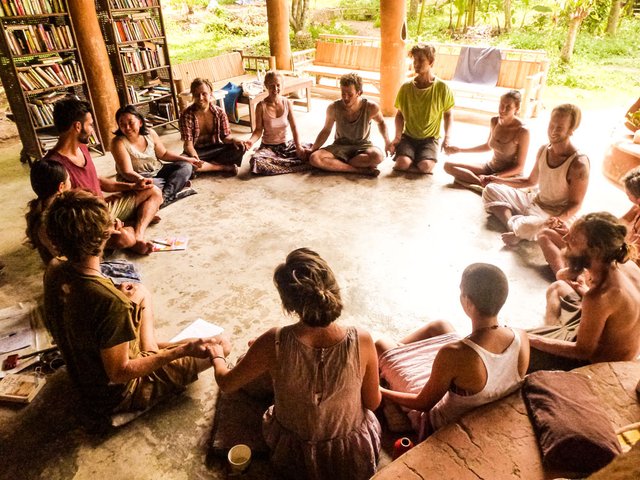
Introduction to Sociocracy
- Sociocracy means governance by those who associate together
- It is also known as "dynamic governance"
- Based on equal power of all members
- Begin with the aim in mind - express the group’s mission statement
- With a mission commonly agreed upon, every decision should be in support of that mission
- For intentional communities, what defines its aim?
a) Housing only or also business and education?
b) Social change model?
c) Relationship to surrounding ecology?
d) Finances/affordability of housing?
e) Governance method?
f) Controversial issues, ex possession of firearms on site? - Dynamic governance - how are we going to govern ourselves?
a) Organizational structure - circles
b) Decision making - consent
c) Continual adaption - feedback
Decision making
- While working in a group, the practice is to have a circle facilitator and everyone else is a circle member
- The typical practice is to go around in the group, and let everyone have a chance to speak
- First step is “picture forming” - present the issues, identify the dimensions of the issue, agreement that the list of dimensions is complete
- Second step is “proposal shaping” - come up with proposal ideas, organize ideas into complete proposal, agreement that the proposal deals with all dimensions of the issue
- Third step is “consenting to a proposal” - proposal is presented, a round of clarifying questions occurs, a second round occurs of quick opinions, based on this second round there may be some adjustments on the proposal, final round is the consent round, if there are no objections in the consent round then the proposal is announced, if there are objections in the consent round then there are multiple potential paths (facilitator or original proposer amends the proposal, new round of discussion about how to amend the proposal, bring in an ad hoc helping circle)
- Why should we consent to a proposal or not?
a) Does this proposal support the group’s mission?
b) Does anyone in the circle have a reasoned objection to the proposal?
c) Is this proposal within everyone’s range of tolerance (ex if we are deciding on communal meals and someone prefers vegetarian but will eat meat, then it is tolerable that the communal meals will include meat; however, if someone is strictly vegetarian, then it is not tolerable that the communal meals will include meat)
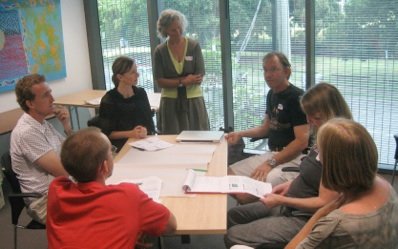
Roles in a circle (leader, delegate, facilitator, secretary)
- Must define role, term, and qualifications (ex facilitator, 1 year, listener)
- Then, everyone in the group submits a nomination form
- A round occurs, in which everyone states who they nominated and why
- A second round occurs, in which people are able to change their nominations if desired
- The facilitator will, after hearing everyone’s reasonings, propose a candidate and explain why
- A consent round occurs, asking if there are any objections to this person filling this particular role, with the candidate being asked last
- If there are objections, same cycle occurs when there are objections to a proposal (facilitator or original proposer amends the proposal, new round of discussion about how to amend the proposal, bring in an ad hoc helping circle)
Consensus vs consent
- Is there a difference between consensus and consent?
- Consensus asks if you agree, consent asks if you object
- In sociocracy, consent is used because not seeking what is perfect for everyone, but “what is good enough for now”
Organizational structure - circles
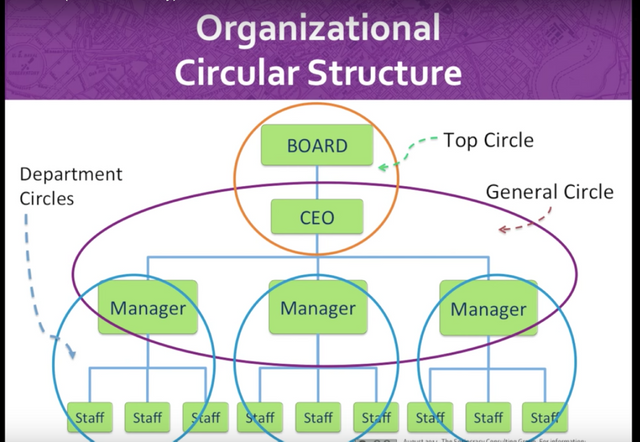
- Department circles - staff and manager of a particular working group are circled together and have equal voice
- General circle - managers of department circles and CEO are circled together and have equal voice, they are accountable for getting things done within the policies set by the general circle
- Top circle - CEO, general circle delegate, and board are circled together and have equal voice
- Top circle - advantage of having outside people on the board that are experts in their fields, as well as the voice of the CEO and general circle delegate, therefore the board and the organization are not separate decision making powers
- Some examples of experts could be legal governmental expert, social organization expert, financial economic expert, aim expert
- Top circle selects the CEO
- Double link -
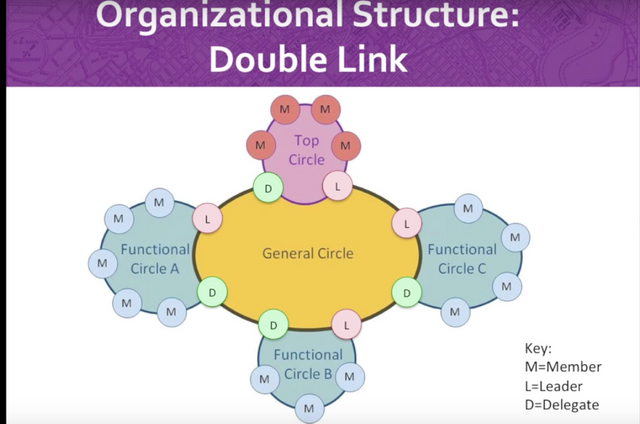
- Authority for policy decisions is delegated to functional circles, with distinct aims and domains
- Every circle has members and a delegate (selected by the lower circle) and a leader (selected by the upper circle)
- Each circle is connected to the higher up circle through their delegate and leader
- Each functional circle can have sub-circles
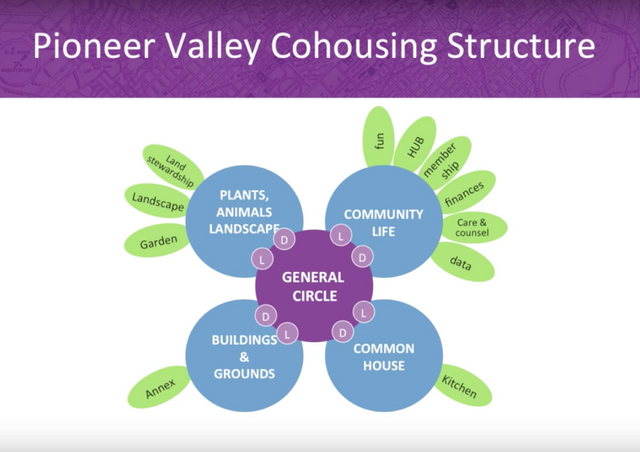
Continual adaptation/ feedback loops
- Make a plan, carry out the plan, then measure how effective the plan was
- There is also feedback for people carrying out certain roles —> select a person to role for a term, that person carries out the role, and then midterm their role and how they performed in that role is reviewed and improvements are suggested
- There is also feedback for policies —> consent to policy with term, carry out policy, measure the effect of the policy, amend the policy if needed, consent to the amended policy, carry out amended policy, and so on
- If a question arises, then it goes to a work circle
that circle may make a decision, or it may first seek help in coming to a decision via the general circle, ad hoc helping circle, and/or a community conversation
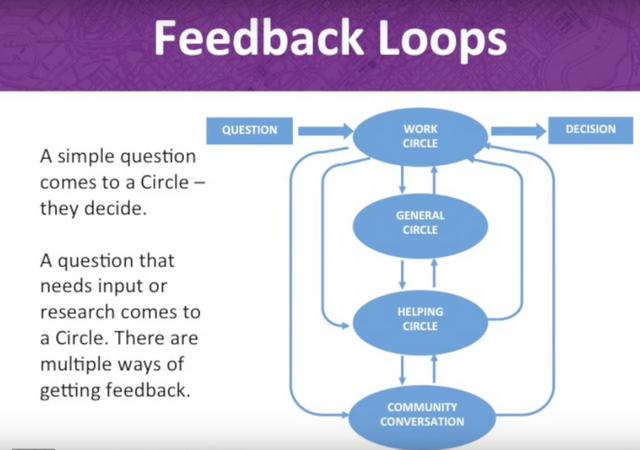
- Policies are never set in stone, they always have a term
- At the end of the term they will be reviewed and amended
Examples
- Examples of people actually practicing sociocracy - PULSE, Austin Waldorf School, Creative Urethanes, Rainbow Mountain School, Sojourns Community Health Clinic
- Examples of intentional communities practicing sociocracy - Pioneer Valley Cohousing Community, Champlain Valley Cohousing, Belfast Cohousing & Ecovillage, Cohabitat Quebec, Columbia Ecovillage, Rocky Corner Cohousing, Ecovillage at Loudoun County, Windsong Cohousing
Does anyone in the Steemit community know of other intentional communities practicing sociocracy?
Perhaps you know another governance method that an intentional community has succesfully used? If so I'd love to hear about it!
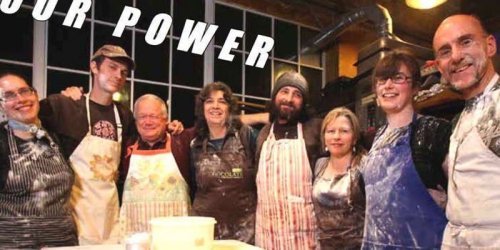
Steemit isn't showing pictures right now but I read the text.
Having worked with many volunteers on our farm, the most important thing is to be surrounded by the right people. That is a very important thing. When you have a small group of people that are on the same communication level you are ready to start. It is not an easy job in reality to start up a community, but not impossible . There must be a consensus, the regulations come only after some problems occur. There is never a perfect model that fits for all, we are all too different. Having different models in different climates and cultures is having like a biodiversity of models that support each-other. Not all trees can live together, neither can we.
very informative @anwenbaumeister. I watched the video, it explains it pretty well. keep it up, gonna follow you!
Commenting as a reminder to come back and read this post more indepth.
I think Democracy as we currently have it is an outdated method of governing that worked when representatives had to travel with horse and buggy across the nation to meet with other politicians on behalf of their constituents.
Now we're all so connected there seems little need for some man in a suit to attempt to represent the nuances views of his entire electorate. Sociocracy might be the system I am looking for.
I see this is the formation of an organizational structure that is very complete, well planned, and highly measurable.
I also see this organization system taking decisions by deliberations to reach agreement by involving its members.
The formation of such an organization is very good.
Thank you for giving form to the steemian proposal, hopefully what you give be good.
Nice! @ anwenbaumeister you have explain CMM level here in all format...
Its an interesting concept and i like to see it play out.... but what do you think about the fact that we are a reward driven society?
Hi @anwenbaumeister !!
nice topic , and great work and pictures as well. nice to know about this. keep it up. see u soon.
UPVOTED
Reminds me a lot to how the Catalan Integral Cooperative works:
"Catalan Integral Cooperative is organized through fortnightly open assemblies where decisions about its functioning are taken. In these assemblies which are called ‘permanent assemblies’, among other issues, the tasks carried out by different commisions and working groups are reviewed. Also, if need be, creation of new working groups and commisions can be aggreed upon.
Working commissions are constructed as nodes. These comprise and interrelate various commissions that have a certain relation with one and other.
How we understand a commission is, a stable group of people carrying out a necessary task for the proper functioning of the cooperative. Commissions propose actions and fields of work, develop them and present their current states and results during permanent assemblies"
"The assemblies are the decision-making organs.Throughout the process, a minimum agreement on the basic principals should be reached, that should come to terms with all the projects within the framework of Integral Cooperative, as a tool to generate self-sufficient, affinity, mutual help networks and equality, based on self-management and assembly. We support a decentralized decision-making process, fundamental to the autonomy and empowerment of the cooperative through solidarity, ruling out bureaucracy and encouraging confidence and free will. Each cooperative project, working commission, eco-network or local group make their own decisions, always respecting the agreements reached within the framework of the CIC. ¨
http://wiki.p2pfoundation.net/Catalan_Integral_Cooperative
liked